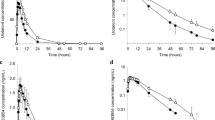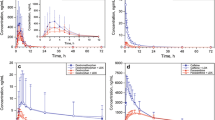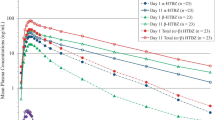Abstract
Background
Traxoprodil, a substituted 4-phenylpiperidine, is an N-methyl-D-aspartate (NMDA) receptor antagonist that is selective for receptors containing the NR2B subunit. In vivo and in vitro studies examining the disposition of traxoprodil have demonstrated that it is mainly metabolised by cytochrome P450 (CYP) 2D6, a major drug-metabolising enzyme that exhibits a genetic polymorphism.
Objective
To assess the single-dose absolute oral bioavailability of traxoprodil in healthy male volunteers phenotyped as either CYP2D6 extensive or poor metabolisers.
Methods
This was an open-label, three-way crossover study. Traxoprodil was administered as a single dose orally in solution of 50, 100 and 300mg and intravenously as a constant rate 2-hour infusion of 50 and 100mg. CYP2D6 phenotype was assigned following single-dose dextromethorphan administration.
Results
In poor metabolisers (n = 6), oral bioavailability was ∼80% and was consistent with a liver extraction ratio of ∼20% (plasma clearance of ∼4 mL/min/ kg) indicating near complete absorption. Following intravenous administration, the mean volume of distribution at steady state (Vss) was moderate (∼6.5 L/kg) and the mean elimination half-life (t1/2) was ∼20 hours. Following oral administration the mean maximum plasma concentration (Cmax) and area under the plasma concentration-time curve from time zero to infinity (AUC∞) increased approximately proportionally with dose. In extensive metabolisers (n = 11), oral bioavailability was dose-dependent and nonlinear. At the 100mg dose, the absolute oral bioavailability was ∼39.5%. Overall, the oral bioavailability ranged from 22.8% to 62.1% and its estimation was confounded by large differences in plasma concentrations at oral doses without equivalent intravenous doses. Following intravenous administration, plasma clearance was high (∼27 mL/min/kg), the Vss was moderate (∼4 L/Kg) and the t1/2 was ∼2–4 hours. Following oral administration the Cmax and AUC∞ increased more than proportionally with dose. Apparent oral clearance decreased with increasing oral dose. However, t1/2 was approximately the same at all doses (∼4 hours).
Conclusion
The pharmacokinetics of traxoprodil were quite different in the two phenotypes. In extensive metabolisers, the oral bioavailability was nonlinear and dose-dependent, while in poor metabolisers, oral bioavailability appeared to be linear and dose-independent. Based on the pharmacokinetics in extensive and poor metabolisers, the nonlinear oral bioavailability in extensive metabolisers may be attributed to saturation of hepatic first-pass CYP2D6 metabolism. Thus, at a high oral dose, the impact of CYP2D6 metabolism on traxoprodil pharmacokinetics is minimal.










Similar content being viewed by others
References
Chenard BL, Bordner J, Butler TW, et al. (1,S,2S)-1-(4-hydroxy-phenyl)-2-(4-hydroxy-4phenyl-piperidino)-1-proponol: a potent new neuroprotectant which blocks N-methyl-D-aspartate responses. J Med Chem 1995; 38: 3138–45
Low SJ, Roland CL. Review of NMDA antagonist-induced neurotoxicity and implications for clinical development. Int J Clin Pharmacol Ther 2004; 42: 1–14
Menniti FS, Chenard BL, Butler TW, et al. CP-101,606: a potent neuroprotectant selective for forebrain neurons. Eur J Pharmacol 1997; 331: 117–26
Menniti FS, Shah AK, Williams SA, et al. CP-101,606: an NR2B-selective NMDA receptor antagonist. CNS Drug Rev 1998; 4: 307–22
Wessell RH, Almed SM, Menniti FS, et al. NR2B selective NMDA receptor antagonist CP-101,606 prevents levodopa-induced motor response alterations in hemi-parkinsonian rats. Neuropharmacology 2004; 47: 184–94
Zhanger UM, Eichelbaum M. Section II: enzymes and transporters. In: Levy RH, Thummel KE, Trager WF, et al., editors. Metabolic drug interactions. New York (NY): Lippincott Williams and Wilkins, 2000
Johnson K, Shah A, Jaw-Tsai S, et al. Metabolism, pharmacokinetics and excretion of a highly selective N-methyl-D-aspartate receptor antagonist, traxoprodil in human cytochrome P450 2D6 extensive and poor metabolizers. Drug Metab Dispos 2003; 31: 76–87
Johansson I, Lundquist E, Bertilsson L, et al. Inherited amplification of an active gene in the CYP2 locus as a cause of ultrarapid metabolism of debrisoquine. Proc Natl Acad Sci 1993; 90: 11825–9
Bullock MR, Merchant RE, Carrmack CA, et al. An open-label study of CP-101,606 in subjects with a severe traumatic head injury or spontaneous intracerebral hemorrhage. Ann N Y Acad Sci 1999; 890: 51–8
Merchant RE, Bullock MR, Carmack CA, et al. A double-blind placebo-controlled study of the safety, tolerability and pharmacokinetics of CP-101,606 in patients with a mild or moderate traumatic brain injury. Ann N Y Acad Sci 1999; 890: 42–50
Kwan KC. Oral bioavailability and first pass effect. Drug Metab Dispos 1997; 25: 1329–36
Rowland M, Tozer TN. Clinical pharmacokinetics. 2nd ed. Philadelphia: Lea & Febiger, 1989: 255–75
Madani S, Paine MF, Lewis L, et al. Comparison of CYP2D6 content and metoprolol oxidation between microsomes isolated from human livers and small intestines. Pharm Res 1999; 16: 1199–205
Paine MF, Shen DD, Kunze KL, et al. First-pass metabolism of midazolam by the human intestine. Clin Pharmacol Ther 1996; 60: 14–24
Obach RS. Prediction of human clearance of twenty-nine drugs from hepatic microsomal intrinsic clearance data: an examination of in vitro half-life approach and nonspecific binding to microsomes. Drug Metab Dispos 1999; 27: 1350–9
Venkatakrishnan K, von Moltke LL, Obach RS, et al. Microsomal binding of amitriptyline: effect on estimation of enzyme kinetic parameters in vitro. J Pharmacol Exp Ther 2000; 293: 343–50
Shimada T, Yamazaki H, Mimura M, et al. Interindividual variations in human liver cytochrome P450 enzymes involved in the oxidation of drugs, carcinogens and toxic chemicals: studies with liver microsomes of 30 Japanese and 30 Caucasians. J Pharmacol Exp Ther 1994; 270: 414–23
Acknowledgements
This study was presented in part at the American Association for Pharmaceutical Scientists Annual Meeting in Baltimore, MD, October 2004.
This work was funded by Pfizer Inc. All authors are employees of Pfizer Inc.
Author information
Authors and Affiliations
Corresponding author
Rights and permissions
About this article
Cite this article
Taylor, T.J., Diringer, K., Russell, T. et al. Absolute Oral Bioavailability of Traxoprodil in Cytochrome P450 2D6 Extensive and Poor Metabolisers. Clin Pharmacokinet 45, 989–1001 (2006). https://doi.org/10.2165/00003088-200645100-00003
Published:
Issue Date:
DOI: https://doi.org/10.2165/00003088-200645100-00003




